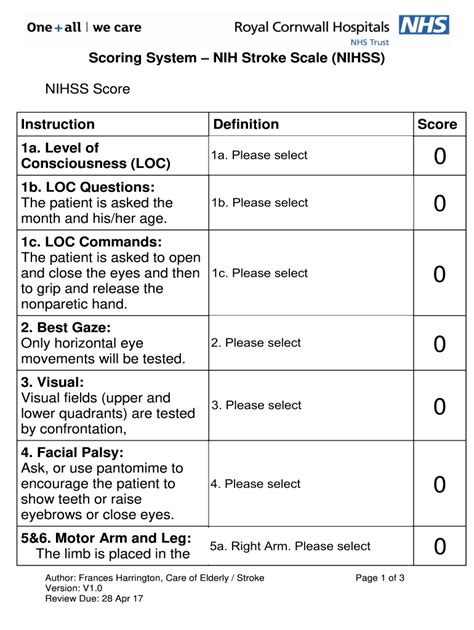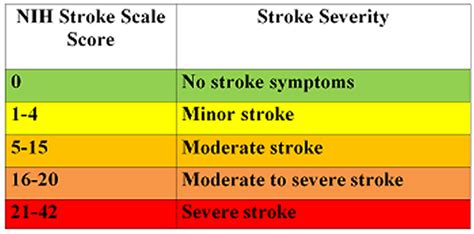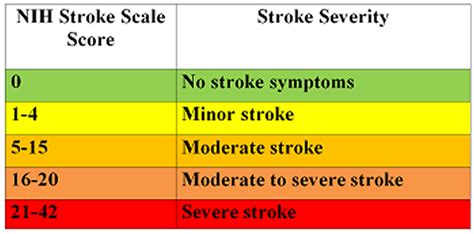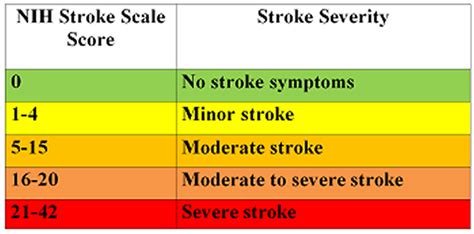Decoding NIH Stroke Scale 8: Insight into Stroke Severity

Unlock the significance of NIH Stroke Scale 8: Gain insights into stroke severity and enhance clinical decision-making with this informative article.
In the realm of healthcare assessment, the NIH Stroke Scale (NIHSS) serves as a pivotal tool in evaluating the severity of strokes, offering a standardized metric to guide clinical decision-making. Amidst this framework, a score of 8 on the NIHSS delineates a specific level of impairment and provides clinicians with critical insights into the neurological status of patients following a stroke event. This article endeavors to elucidate the significance of a NIHSS score of 8 within the context of stroke management and patient care. Through a comprehensive exploration of pertinent healthcare topics, ranging from the components comprising the NIHSS assessment to the implications of a score of 8 on patient prognosis, this discourse aims to equip readers with a nuanced understanding of stroke evaluation and its clinical ramifications.
Top 10 Points about NIH Stroke Scale of 8 means :
- Understanding NIH Stroke Scale
- Components of the NIH Stroke Scale Assessment
- Interpreting a Score of 8 on the NIH Stroke Scale
- Neurological Implications of a Score of 8
- Stroke Severity and Patient Prognosis
- Clinical Decision-Making Based on NIH Stroke Scale Scores
- Importance of Timely Assessment in Stroke Management
- Utilizing NIH Stroke Scale 8 in Treatment Planning
- Rehabilitation Strategies for Patients with a Score of 8
- Long-Term Care Considerations for Individuals with Stroke Severity
Several facts about NIH Stroke Scale of 8 means
Understanding NIH Stroke Scale

Overview:
The NIH Stroke Scale (NIHSS) is a standardized tool used by healthcare professionals to assess the severity of a stroke and its impact on a patient's neurological function. It consists of various tests and evaluations designed to measure different aspects of brain function.
Key Components:
The NIHSS evaluates the patient's level of consciousness, eye movement, motor function, language skills, and sensory perception. Each component is scored individually, and the total score provides an indication of the severity of the stroke.
Importance:
Understanding the NIH Stroke Scale is crucial for healthcare providers as it helps them determine the appropriate course of treatment and monitor the patient's progress over time.
Interpreting a Score of 8 on the NIH Stroke Scale

Significance of a Score of 8:
A score of 8 on the NIH Stroke Scale indicates moderate impairment in neurological function. This score suggests that the patient may have difficulty with certain tasks and may require assistance with daily activities.
Implications for Treatment:
Healthcare providers use the NIHSS score to guide treatment decisions, such as the administration of clot-busting medications or the need for rehabilitation therapy.
Prognosis:
The NIHSS score can also help predict the patient's long-term prognosis and likelihood of recovery. A score of 8 suggests a moderate level of impairment, but with appropriate treatment and rehabilitation, many patients can experience significant improvement in their symptoms.
Neurological Implications of a Score of 8

Brain Function:
A score of 8 on the NIH Stroke Scale indicates dysfunction in specific areas of the brain, such as motor control, language processing, and sensory perception. These impairments can significantly impact the patient's quality of life and ability to perform daily tasks.
Localized Damage:
The specific symptoms experienced by a patient with a score of 8 may vary depending on the location and extent of the brain damage. Healthcare providers must carefully assess the patient's symptoms and develop a tailored treatment plan to address their individual needs.
Stroke Severity and Patient Prognosis

Impact on Recovery:
The severity of a stroke, as indicated by the NIHSS score, can significantly influence the patient's recovery process. Patients with higher scores may experience more profound and long-lasting effects, requiring intensive rehabilitation and long-term support.
Recovery Potential:
While a score of 8 suggests moderate impairment, many patients can still make meaningful improvements with the right treatment and support. Rehabilitation therapy, including physical, occupational, and speech therapy, can help patients regain lost function and improve their quality of life.
Clinical Decision-Making Based on NIH Stroke Scale Scores

Treatment Planning:
Healthcare providers use the NIHSS score to guide treatment decisions and develop a comprehensive care plan for patients who have experienced a stroke. This may include medications, rehabilitation therapy, and lifestyle modifications to reduce the risk of future strokes.
Monitoring Progress:
The NIH Stroke Scale is also used to monitor the patient's progress over time and adjust treatment strategies as needed. Regular assessments help healthcare providers track improvements in neurological function and make necessary adjustments to optimize patient outcomes.
Utilizing NIH Stroke Scale 8 in Treatment Planning

Individualized Care:
Each patient with a score of 8 on the NIH Stroke Scale requires a personalized treatment plan tailored to their specific needs and goals. Healthcare providers consider factors such as age, overall health, and lifestyle when developing a care plan.
Multidisciplinary Approach:
Effective treatment planning often involves collaboration between various healthcare professionals, including neurologists, physical therapists, occupational therapists, and speech therapists. This multidisciplinary approach ensures that all aspects of the patient's recovery are addressed.
Long-Term Care Considerations for Individuals with Stroke Severity

Challenges of Long-Term Care:
Patients with a score of 8 on the NIH Stroke Scale may face ongoing challenges related to their stroke, including physical disabilities, cognitive impairments, and emotional difficulties. Long-term care planning is essential to address these needs and ensure the patient's well-being.
Supportive Services:
Long-term care may involve a range of supportive services, such as home healthcare, assisted living facilities, or skilled nursing care. These services provide assistance with activities of daily living and help patients maintain their independence to the greatest extent possible.
Sources:
1. National Institute of Neurological Disorders and Stroke. (n.d.). NIH Stroke Scale. Retrieved from https://www.ninds.nih.gov/Disorders/All-Disorders/NIH-Stroke-Scale
2. American Stroke Association. (2022). About Stroke Scales. Retrieved from https://www.stroke.org/en/about-stroke/scales
NIH Stroke Scale of 8 means in Professional's eye
The
NIH Stroke Scale (NIHSS) serves as a critical tool in the realm of healthcare, offering a standardized method for assessing the severity of strokes and guiding treatment decisions. When a patient receives a score of
8 on the NIHSS, it signifies a moderate level of impairment in neurological function, prompting healthcare professionals to carefully consider the implications for treatment and prognosis. This score, indicative of specific deficits in motor control, language processing, and sensory perception, underscores the need for tailored care plans aimed at addressing the individualized needs of the patient. Effective treatment planning hinges upon a multidisciplinary approach, involving collaboration between neurologists, physical therapists, occupational therapists, and speech therapists, to optimize patient outcomes and promote recovery. Furthermore, long-term care considerations for individuals with stroke severity extend beyond initial interventions, necessitating ongoing support services and adaptive strategies to facilitate the patient's adjustment to life post-stroke. Through the utilization of the NIH Stroke Scale, healthcare providers can meticulously monitor the patient's progress over time, adjusting treatment strategies as needed to promote optimal recovery and enhance quality of life.
Point of Views : NIH Stroke Scale of 8 means
The
NIH Stroke Scale (NIHSS) is a standardized tool utilized by healthcare professionals to assess the severity of strokes and determine the appropriate course of treatment for patients.A score of
8 on the NIHSS indicates a moderate level of impairment in neurological function, highlighting specific deficits in motor control, language processing, and sensory perception.Healthcare providers must carefully interpret a score of
8 on the NIHSS to guide treatment decisions and develop tailored care plans suited to the individual needs of the patient.Treatment planning for individuals with a score of
8 on the NIHSS requires a multidisciplinary approach, involving collaboration between neurologists, physical therapists, occupational therapists, and speech therapists.Long-term care considerations for patients with stroke severity extend beyond initial interventions, necessitating ongoing support services and adaptive strategies to facilitate adjustment to life post-stroke.Regular monitoring of the patient's progress over time is essential, allowing healthcare providers to make necessary adjustments to treatment strategies and optimize recovery outcomes.
Conclusion :As we conclude our discussion on the significance of the NIH Stroke Scale (NIHSS) and its implications for patients with a score of 8, it is imperative to underscore the importance of informed decision-making in stroke management. By comprehensively understanding the NIH Stroke Scale and its nuanced interpretation, healthcare providers can effectively tailor treatment plans to address the specific needs of patients experiencing moderate impairment in neurological function. Through a multidisciplinary approach, involving collaboration among various healthcare professionals, individuals with a score of 8 on the NIHSS can access comprehensive care aimed at optimizing their recovery and enhancing their quality of life.
Furthermore, it is crucial to recognize that the journey towards recovery for patients with stroke severity extends beyond the acute phase of treatment. Long-term care considerations, including ongoing support services and adaptive strategies, play a pivotal role in facilitating the patient's adjustment to life post-stroke. By integrating regular monitoring and assessment into the care continuum, healthcare providers can track progress over time, make necessary adjustments to treatment strategies, and ultimately empower patients to achieve their maximum potential in the face of neurological challenges.
Questions and Answer for NIH Stroke Scale of 8 means
What does a NIH Stroke Scale of 8 mean?
- Answer: A NIH Stroke Scale (NIHSS) score of 8 indicates a moderate level of impairment in neurological function following a stroke. It suggests specific deficits in motor control, language processing, and sensory perception.
How is the NIH Stroke Scale score of 8 interpreted by healthcare professionals?
- Answer: Healthcare professionals interpret a NIH Stroke Scale score of 8 by considering the patient's level of impairment in various neurological functions. This score guides treatment decisions and helps in developing tailored care plans for the patient's needs.
What treatments are recommended for individuals with a NIH Stroke Scale score of 8?
- Answer: Treatment recommendations for individuals with a NIH Stroke Scale score of 8 may include medications, rehabilitation therapy, and lifestyle modifications. The goal is to optimize recovery and improve the patient's quality of life.
Can a patient with a NIH Stroke Scale score of 8 fully recover?
- Answer: While recovery outcomes vary for each individual, many patients with a NIH Stroke Scale score of 8 can experience significant improvement with appropriate treatment and rehabilitation. However, full recovery may not always be achievable, and ongoing support may be necessary.
How long does it take to recover from a stroke with a NIH Stroke Scale score of 8?
- Answer: The recovery timeline for a stroke with a NIH Stroke Scale score of 8 varies depending on factors such as the severity of the stroke, the effectiveness of treatment, and the individual's overall health. Some patients may experience noticeable improvement within weeks or months, while others may require longer-term rehabilitation.
Label :NIH Stroke Scale, Stroke Severity, Healthcare Management
Keyword : NIH Stroke Scale of 8 means

Unlock the significance of NIH Stroke Scale 8: Gain insights into stroke severity and enhance clinical decision-making with this informative article.
In the realm of healthcare assessment, the NIH Stroke Scale (NIHSS) serves as a pivotal tool in evaluating the severity of strokes, offering a standardized metric to guide clinical decision-making. Amidst this framework, a score of 8 on the NIHSS delineates a specific level of impairment and provides clinicians with critical insights into the neurological status of patients following a stroke event. This article endeavors to elucidate the significance of a NIHSS score of 8 within the context of stroke management and patient care. Through a comprehensive exploration of pertinent healthcare topics, ranging from the components comprising the NIHSS assessment to the implications of a score of 8 on patient prognosis, this discourse aims to equip readers with a nuanced understanding of stroke evaluation and its clinical ramifications.
Top 10 Points about NIH Stroke Scale of 8 means :
- Understanding NIH Stroke Scale
- Components of the NIH Stroke Scale Assessment
- Interpreting a Score of 8 on the NIH Stroke Scale
- Neurological Implications of a Score of 8
- Stroke Severity and Patient Prognosis
- Clinical Decision-Making Based on NIH Stroke Scale Scores
- Importance of Timely Assessment in Stroke Management
- Utilizing NIH Stroke Scale 8 in Treatment Planning
- Rehabilitation Strategies for Patients with a Score of 8
- Long-Term Care Considerations for Individuals with Stroke Severity
Several facts about NIH Stroke Scale of 8 means
Understanding NIH Stroke Scale

Overview:
The NIH Stroke Scale (NIHSS) is a standardized tool used by healthcare professionals to assess the severity of a stroke and its impact on a patient's neurological function. It consists of various tests and evaluations designed to measure different aspects of brain function.
Key Components:
The NIHSS evaluates the patient's level of consciousness, eye movement, motor function, language skills, and sensory perception. Each component is scored individually, and the total score provides an indication of the severity of the stroke.
Importance:
Understanding the NIH Stroke Scale is crucial for healthcare providers as it helps them determine the appropriate course of treatment and monitor the patient's progress over time.
Interpreting a Score of 8 on the NIH Stroke Scale

Significance of a Score of 8:
A score of 8 on the NIH Stroke Scale indicates moderate impairment in neurological function. This score suggests that the patient may have difficulty with certain tasks and may require assistance with daily activities.
Implications for Treatment:
Healthcare providers use the NIHSS score to guide treatment decisions, such as the administration of clot-busting medications or the need for rehabilitation therapy.
Prognosis:
The NIHSS score can also help predict the patient's long-term prognosis and likelihood of recovery. A score of 8 suggests a moderate level of impairment, but with appropriate treatment and rehabilitation, many patients can experience significant improvement in their symptoms.
Neurological Implications of a Score of 8

Brain Function:
A score of 8 on the NIH Stroke Scale indicates dysfunction in specific areas of the brain, such as motor control, language processing, and sensory perception. These impairments can significantly impact the patient's quality of life and ability to perform daily tasks.
Localized Damage:
The specific symptoms experienced by a patient with a score of 8 may vary depending on the location and extent of the brain damage. Healthcare providers must carefully assess the patient's symptoms and develop a tailored treatment plan to address their individual needs.
Stroke Severity and Patient Prognosis

Impact on Recovery:
The severity of a stroke, as indicated by the NIHSS score, can significantly influence the patient's recovery process. Patients with higher scores may experience more profound and long-lasting effects, requiring intensive rehabilitation and long-term support.
Recovery Potential:
While a score of 8 suggests moderate impairment, many patients can still make meaningful improvements with the right treatment and support. Rehabilitation therapy, including physical, occupational, and speech therapy, can help patients regain lost function and improve their quality of life.
Clinical Decision-Making Based on NIH Stroke Scale Scores

Treatment Planning:
Healthcare providers use the NIHSS score to guide treatment decisions and develop a comprehensive care plan for patients who have experienced a stroke. This may include medications, rehabilitation therapy, and lifestyle modifications to reduce the risk of future strokes.
Monitoring Progress:
The NIH Stroke Scale is also used to monitor the patient's progress over time and adjust treatment strategies as needed. Regular assessments help healthcare providers track improvements in neurological function and make necessary adjustments to optimize patient outcomes.
Utilizing NIH Stroke Scale 8 in Treatment Planning

Individualized Care:
Each patient with a score of 8 on the NIH Stroke Scale requires a personalized treatment plan tailored to their specific needs and goals. Healthcare providers consider factors such as age, overall health, and lifestyle when developing a care plan.
Multidisciplinary Approach:
Effective treatment planning often involves collaboration between various healthcare professionals, including neurologists, physical therapists, occupational therapists, and speech therapists. This multidisciplinary approach ensures that all aspects of the patient's recovery are addressed.
Long-Term Care Considerations for Individuals with Stroke Severity

Challenges of Long-Term Care:
Patients with a score of 8 on the NIH Stroke Scale may face ongoing challenges related to their stroke, including physical disabilities, cognitive impairments, and emotional difficulties. Long-term care planning is essential to address these needs and ensure the patient's well-being.
Supportive Services:
Long-term care may involve a range of supportive services, such as home healthcare, assisted living facilities, or skilled nursing care. These services provide assistance with activities of daily living and help patients maintain their independence to the greatest extent possible.
Sources:
1. National Institute of Neurological Disorders and Stroke. (n.d.). NIH Stroke Scale. Retrieved from https://www.ninds.nih.gov/Disorders/All-Disorders/NIH-Stroke-Scale
2. American Stroke Association. (2022). About Stroke Scales. Retrieved from https://www.stroke.org/en/about-stroke/scales
NIH Stroke Scale of 8 means in Professional's eye
The
NIH Stroke Scale (NIHSS) serves as a critical tool in the realm of healthcare, offering a standardized method for assessing the severity of strokes and guiding treatment decisions. When a patient receives a score of
8 on the NIHSS, it signifies a moderate level of impairment in neurological function, prompting healthcare professionals to carefully consider the implications for treatment and prognosis. This score, indicative of specific deficits in motor control, language processing, and sensory perception, underscores the need for tailored care plans aimed at addressing the individualized needs of the patient. Effective treatment planning hinges upon a multidisciplinary approach, involving collaboration between neurologists, physical therapists, occupational therapists, and speech therapists, to optimize patient outcomes and promote recovery. Furthermore, long-term care considerations for individuals with stroke severity extend beyond initial interventions, necessitating ongoing support services and adaptive strategies to facilitate the patient's adjustment to life post-stroke. Through the utilization of the NIH Stroke Scale, healthcare providers can meticulously monitor the patient's progress over time, adjusting treatment strategies as needed to promote optimal recovery and enhance quality of life.
Point of Views : NIH Stroke Scale of 8 means
The
NIH Stroke Scale (NIHSS) is a standardized tool utilized by healthcare professionals to assess the severity of strokes and determine the appropriate course of treatment for patients.A score of
8 on the NIHSS indicates a moderate level of impairment in neurological function, highlighting specific deficits in motor control, language processing, and sensory perception.Healthcare providers must carefully interpret a score of
8 on the NIHSS to guide treatment decisions and develop tailored care plans suited to the individual needs of the patient.Treatment planning for individuals with a score of
8 on the NIHSS requires a multidisciplinary approach, involving collaboration between neurologists, physical therapists, occupational therapists, and speech therapists.Long-term care considerations for patients with stroke severity extend beyond initial interventions, necessitating ongoing support services and adaptive strategies to facilitate adjustment to life post-stroke.Regular monitoring of the patient's progress over time is essential, allowing healthcare providers to make necessary adjustments to treatment strategies and optimize recovery outcomes.
Conclusion :As we conclude our discussion on the significance of the NIH Stroke Scale (NIHSS) and its implications for patients with a score of 8, it is imperative to underscore the importance of informed decision-making in stroke management. By comprehensively understanding the NIH Stroke Scale and its nuanced interpretation, healthcare providers can effectively tailor treatment plans to address the specific needs of patients experiencing moderate impairment in neurological function. Through a multidisciplinary approach, involving collaboration among various healthcare professionals, individuals with a score of 8 on the NIHSS can access comprehensive care aimed at optimizing their recovery and enhancing their quality of life.
Furthermore, it is crucial to recognize that the journey towards recovery for patients with stroke severity extends beyond the acute phase of treatment. Long-term care considerations, including ongoing support services and adaptive strategies, play a pivotal role in facilitating the patient's adjustment to life post-stroke. By integrating regular monitoring and assessment into the care continuum, healthcare providers can track progress over time, make necessary adjustments to treatment strategies, and ultimately empower patients to achieve their maximum potential in the face of neurological challenges.
Questions and Answer for NIH Stroke Scale of 8 means
What does a NIH Stroke Scale of 8 mean?
- Answer: A NIH Stroke Scale (NIHSS) score of 8 indicates a moderate level of impairment in neurological function following a stroke. It suggests specific deficits in motor control, language processing, and sensory perception.
How is the NIH Stroke Scale score of 8 interpreted by healthcare professionals?
- Answer: Healthcare professionals interpret a NIH Stroke Scale score of 8 by considering the patient's level of impairment in various neurological functions. This score guides treatment decisions and helps in developing tailored care plans for the patient's needs.
What treatments are recommended for individuals with a NIH Stroke Scale score of 8?
- Answer: Treatment recommendations for individuals with a NIH Stroke Scale score of 8 may include medications, rehabilitation therapy, and lifestyle modifications. The goal is to optimize recovery and improve the patient's quality of life.
Can a patient with a NIH Stroke Scale score of 8 fully recover?
- Answer: While recovery outcomes vary for each individual, many patients with a NIH Stroke Scale score of 8 can experience significant improvement with appropriate treatment and rehabilitation. However, full recovery may not always be achievable, and ongoing support may be necessary.
How long does it take to recover from a stroke with a NIH Stroke Scale score of 8?
- Answer: The recovery timeline for a stroke with a NIH Stroke Scale score of 8 varies depending on factors such as the severity of the stroke, the effectiveness of treatment, and the individual's overall health. Some patients may experience noticeable improvement within weeks or months, while others may require longer-term rehabilitation.
Label :NIH Stroke Scale, Stroke Severity, Healthcare Management
Keyword : NIH Stroke Scale of 8 means
0 komentar